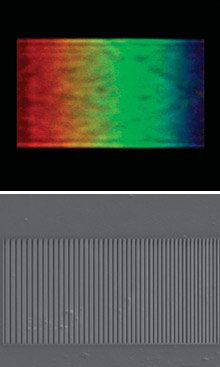 LCDs have been here for quite a while, using the same technology implemented for the first time in the 1970s. It’s high time someone invented a different method of displaying colors in a controlled manner, for the sake of price and energy consumption.
LCDs have been here for quite a while, using the same technology implemented for the first time in the 1970s. It’s high time someone invented a different method of displaying colors in a controlled manner, for the sake of price and energy consumption.
Professor L. Jay Guo, from the University of Michigan, who in the past tinkered with plastic solar cells, is now releasing images of the first color display not based on liquid crystals, but rather on light’s properties when it passes through very narrow openings.
Unlike traditional LCDs that use several layers of optical devices to colorize, polarize and shutter light from a backlight, Guo’s optical film polarizes the light passing through an LCD more efficiently than conventional components can.
The filter is actually a sandwich made from two aluminum layers encasing an insulating material. The entire filter is less than 200 nanometers thick and it etched with slits appearing periodically, just like they do in a grate. The distance between the slits is adjusted to have the wavelengths of the colors in the visible spectrum and determines the color they’ll produce if illuminated by a white backlight.
They created red, blue and green subpixels by sizing the gratings and putting them side by side in a single manufacturing step, unlike classic LCDs, which use pigments to define the base colors and which require a much complex process to manufacture.
Actually, the display Guo proposes boosts the efficiency of LCDs by more than 400 percent, by letting light pass through much easier and transmitting 60 percent of the light (in the example of a green filter), while classic ones only transmit 40 percent.
Also, the gratings polarize the light more efficiently than classic polarizing layers used in LCDs. The old ones absorb 50 percent of the light, while the new ones reflect it in the other direction, hitting a mirror, which reflects it back to the gratings, at the same time flipping some of its polarization.
The new grating approach implemented by Jay Guo not only applies to color displays. He says it can be used in solar cells, to control the reflections and polarizations of light.
Other uses for the invention could be Qualcomm’s new low-power reflective displays, which could combine with the new filter to eliminate the need of a backlight (in normal lighting conditions), says Nicholas Fang, from the University of Illinois at Urbana-Champaign. “There’s a possibility of building this [grating] as a reflective-based color filter,” he says.
Guo and his team now want to develop a technology for the mass production of these filters and to integrate them into everything from cell phones to television sets, all of them much cheaper, greener and easier to build. “We have used continuous roll-to-roll manufacturing to make very similar structures,” he says. “The individual elements are there, and now it’s a matter of integration.”

































